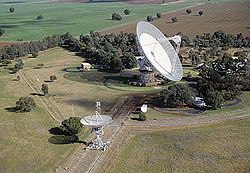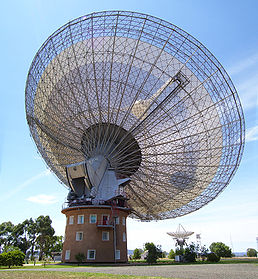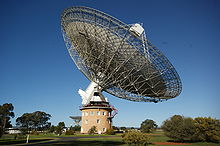- Parkes Observatory
-
Parkes Observatory 
The Parkes Observatory in New South Wales, AustraliaOrganization Australia Telescope National Facility Location  Parkes, NSW, AustraliaCoordinates
Parkes, NSW, AustraliaCoordinatesEstablished 31st October 1961 Website
www.parkes.atnf.csiro.auTelescopesParkes Radio Telescope 64m movable radio dish The Parkes Observatory is a radio telescope observatory, 20 kilometres north of the town of Parkes, New South Wales, Australia. It was one of several radio antennas used to receive live, televised images of the Apollo 11 moon landing on 20 July 1969.
Contents
Radio telescope
The Parkes Radio Telescope, completed in 1961, was the brainchild of E.G. (Taffy) Bowen, chief of the CSIRO's Radiophysics Laboratory. During the Second World War, he had worked on radar development in the US and had made some powerful friends in the scientific community. Calling on this old boy network, he persuaded two philanthropic organisations, the Carnegie Corporation and the Rockefeller Foundation to fund half the cost of the telescope. It was this recognition and key financial support from the US that persuaded then Prime Minister Robert Menzies to agree to fund the rest of the project.[1]
Hardware
The primary observing instrument is the 64-metre movable dish telescope, second largest in the Southern Hemisphere, and one of the first large movable dishes in the world (DSS-43 'Deep Space Station'-43 at Tidbinbilla was extended from 64 m to 70 m in 1987, surpassing Parkes).[2] After its completion it has operated almost continuously to the present day. The dish surface was physically upgraded by adding smooth metal plates to the central part to provide focusing capability for centimetre and millimetre length microwaves. The outer part of the dish remains a fine metal mesh, creating its distinctive two-tone appearance.
The 18m dish antenna in the foreground of the photo was transferred from the Fleurs Observatory (Mills Cross) in 1963. Mounted on rails and powered by a tractor engine to allow the distance between it and the main dish to be easily varied, it was used as an interferometer with the main dish, and as a transmit uplink antenna in the Apollo program. It has been abandoned since the early 1980s.
The telescope has an altazimuth mount. It is guided by a small mock-telescope placed within the structure at the same rotational axes as the dish, but with an equatorial mount. The two are dynamically locked when tracking an astronomical object by a laser guiding system. This primary-secondary approach was designed by Barnes Wallis.
The success of the Parkes telescope led NASA to copy the basic design in their Deep Space Network, with matching 64 m dishes built at Goldstone, Madrid and Tidbinbilla.
Receivers
The receiving cabin is located at the focus of the parabolic dish, supported by three struts 27 metres above the dish. The cabin contains multiple radio and microwave detectors, which can be switched into the focus beam for different science observations.
The observatory is a part of the Australia Telescope National Facility network of radio telescopes. The 64m dish is frequently operated together with the Australia Telescope Compact Array at Narrabri and a single dish at Mopra, to form a very long baseline interferometry array.
Historical non-astronomy research
During the Apollo missions to the moon, the Parkes Observatory was used to relay communication and telemetry signals to NASA, providing coverage for when the moon was on the Australian side of the Earth.[3]
The telescope also played a role in relaying data from the NASA Galileo mission to Jupiter that required radio-telescope support due to the use of its backup telemetry subsystem as the principal means to relay science data.
The observatory has remained involved in tracking numerous space missions up to the present day, including
The observatory and telescope were featured in the 2000 film The Dish, a fictionalised account of the observatory's involvement with the Apollo 11 moon landing.
The CSIRO has made several documentaries on this observatory, with some of these documentaries being posted to YouTube.
Apollo 11 broadcast
When Buzz Aldrin switched on the TV camera on the Lunar Module, three tracking antennas received the signals simultaneously. They were the 64 metre Goldstone antenna in California, the 26 metre antenna at Honeysuckle Creek near Canberra in Australia, and the 64 metre dish at Parkes.
In the first few minutes of the broadcast, NASA alternated between the signals being received from its two stations at Goldstone and Honeysuckle Creek, searching for the best quality picture.
A little under nine minutes into the broadcast, the TV was switched to the Parkes signal. The quality of the TV pictures from Parkes was so superior that NASA stayed with Parkes as the source of the TV for the remainder of the 2.5 hour broadcast. For a comprehensive explanation of the TV reception of the Apollo 11 broadcast, see "The Television Broadcasts" from the report "On Eagles Wings".
On Monday, 31 October 2011, Google replaced it's logo with a Google Doodle in honor of Parkes Observatory's 50th Anniversary.[4] It was only visible on Google in Australia.
Astronomy research timeline
1960s
- Built 1961 and was fully operational by 1963.
- Support for the NASA Apollo Missions in late 1960s.
1970s
- Receiver upgrades and detailed observations begin.
1980s
- Upgrade to 64m from previously smaller aperture.
1990s
- Between 1997 and 2002 it conducted the HIPASS neutral hydrogen survey, the largest blind survey for galaxies in the neutral hydrogen line to date.
2000s
- More than half of currently known pulsars were discovered by the Parkes Observatory.
See also
- Apollo 11 missing tapes
References
- ^ 40 years of The Dish - ABC Science Online
- ^ Canberra Deep Space Communication Complex - exploring the Solar System and beyond
- ^ On Eagle's Wings: The Story of the Parkes Apollo 11 Support
- ^ "Google Doodle Celebrates Parkes Observatory". gizmodo.com.au. 31 Oct 2011. http://www.gizmodo.com.au/2011/10/google-doodle-celebrates-parkes-observatory/. Retrieved November 13, 2011.
External links
 Media related to Parkes Observatory at Wikimedia Commons
Media related to Parkes Observatory at Wikimedia Commons- Parkes Observatory Home Page
- The dish and the great beyond
- ABC Science, 2001: 40 years of the Dish
- View the dish in action
- The Dish at the Internet Movie Database
- Observation of Mariner IV with the Parkes 210-ft Radio Telescope
- The sound of the Universe singing - ABC Radio National radio documentary on the story of 'the dish' since its construction
Categories:- Radio telescopes
- Astronomical observatories in Australia
- Rockefeller Foundation
- Central West, New South Wales
Wikimedia Foundation. 2010.


